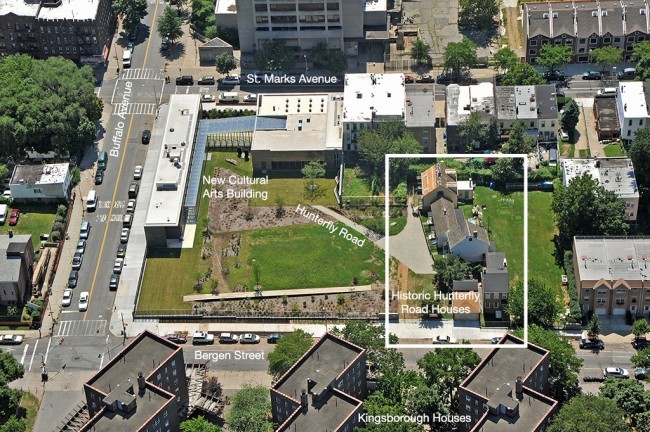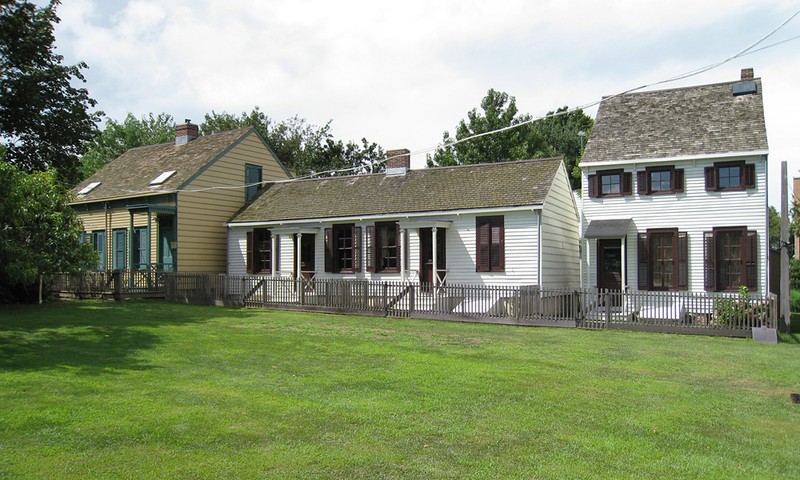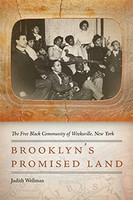Weeksville Heritage Center
Introduction
Text-to-speech Audio
Images
An aerial photograph of Weksville Heritage Center. Photograph by Julian Olivas, courtesy of Caples Jefferson Architects

Hunterfly Road Houses. Wikimedia Commons.

Learn more about the history of Weeksville with this book from NYU Press.

Backstory and Context
Text-to-speech Audio
Weeksville gained its name from an African-American stevedore called James Weeks who, on 26 March 1838, purchased two lots of land near the corner of Troy Avenue and Dean Street in what is now referred to as the Crown Heights section of Brooklyn. Weeks was not the first African-American to buy land in the area; notably, he purchased the properties from Henry C. Thompson who in 1835 secured thirty-two lots of what had constituted part of John Lefferts' (1785-1829) farm. Still, it was Weeks’ name that lasted and in 1839 his address in the Brooklyn Directory was listed as “Weeksville, Bedford” – the first reference to Weeksville as a distinct location.
Slavery in the state of New York was abolished in 1827. Formerly enslaved African-Americans gained their freedom at a time in which land speculation was rampant. This was during a period in which citizenship and the right to vote was still tied to land ownership. In this context the establishment of Weeksville, which always had an above average number of homeowners, allowed Black people to define themselves in their own community and also gave them access to political rights. The investors who purchased and sold land in Weeksville specifically advertised the lots in African-American newspapers or directly targeted African-American homebuyers. The settlers of Weeksville subsequently arrived from Brooklyn and New York, to Maryland and Virginia, to Africa and the Caribbean
Roughly speaking, Weeksville encompassed the area south of Fulton Street, north of East New York Avenue, east of Troy Avenue and west of Ralph Avenue in Brooklyn. Hunterfly Road, an old Native American trail that has now been built over, was a central point of the neighborhood; in the nineteenth century, the road wound southeasterly from what is now Hunterfly Place. Yet, the exact boundaries of Weeksville remain difficult to define. Throughout the nineteenth century, neighborhoods were continuously established, re-formed, re-named, and, eventually, eroded. From the 1840s onwards, sources referred to two African-American communities in Brooklyn - Weeksville and Carrsville, but their borders overlapped and merged with those of Malbonville and Crow Hill. It is easiest to agree with the Brooklyn Eagle reporter, who wrote in 1888 that “it is only possible to give these divisions in a general way, as the ‘oldest inhabitants’ do not agree in laying out the boundaries, and it is a question if the lines were ever very decidedly fixed."
Weeksville was established as an alternative to Black emigration to places like Liberia or Haiti. It provided a community within which African-Americans in New York could escape the racist violence of the post-emancipation period. Its population subsequently increased in the aftermath of the New York City Draft Riots in 1863 and the attendant Black abandonment of Manhattan. In Weeksville, African-Americans created not just a place to live but also a vibrant community. There were two newspapers – Freedom’s Torchlight and the National Monitor – and additional institutions such as the Bethel African Methodist Episcopal Church, the Berean Baptist Church, the Citizens’ Union Cemetery, and Colored School No.2. The latter would become PS. 83 – Brooklyn’s first integrated school. Another important local institution was the Howard Orphan Asylum, which was established after the Colored Orphan Asylum in New York City was burned during the aforementioned draft riots.
The end of the nineteenth century and the start of the twentieth led to dramatic and irreversible changes in Weeksville. Brooklyn gradually incorporated the community and the process was accelerated by the expansion of the grid system and the construction of Eastern Parkway between 1870 and 1874. By the start of the twentieth century a number of the Weeksville institutions had begun to leave, German and Irish immigrants, encouraged by the construction of the Brooklyn Bridge, had made their home alongside African-Americans, and the earlier inhabitants of Weeksville who did not have clear land ownership rights were eventually forced out. Weeksville’s identity as a distinct community disappeared and it became swallowed up into Bedford-Stuyvesant and Crown Heights. The 1941 construction of Kingsborough public housing project effectively dwarfed the historic architecture.
The history of Weeksville remained largely hidden until 1968 when James Hurley, a Professor at Pratt Institute and the head of the Long Island Historical Society, identified three historic houses on what had once been Hunterfly Road. Hurley had been leading walking tours of the area at the time, but actually identified the houses only after the local resident and professional pilot Joseph Haynes provided a low-altitude flight. In 1971, local residents formed the Society for the Preservation of Weeksville and Bedford-Stuyvesant – or the Weeksville Society. Hurley, along with Joan Maynard, a local artist, Patricia Johnson, who worked for the New York City Office of Rent Control, and Dolores McCullough, a court reporter, would play prominent roles in administering the Weeksville Society and attempting to preserve the history of the community.
In 2005, the Weeksville Society opened the Weeksville Heritage Center (WHC), a cultural heritage center built around the now landmarked Hunterfly Road houses that Hurley had identified in 1968. Each house has been restored to represent a different time period (1860s, 1900s, and 1930s), and the WHC offers regular tours of them. The WHC displays exhibitions of its own and provides a space for present day artistic production, these include Funk, God, Jazz, and Medicine: Black Radical Brooklyn in 2014 - a partnership with Creative Time - and Lost Jazz Shrines of Brooklyn in 2015. The WHC also offers community events such as garden parties and farmers' markets. The WHC acts as a repository for the collective memory of Weeksville and operates the 5th of July Resource Center for Self-Determination & Freedom: a collection of archival material and oral history. Today, the WHC is Brooklyn’s largest African-American cultural institution and the only one dedicated to the memory of now extinct African-American communities.
Sources
Scott, Jennifer. "Reimagining Freedom in the Twenty-first Century at a Post-Emancipation Site." The Public Historian 37 (May 2015): 73-88.
Wellman, Judith. Brooklyn’s Promised Land: The Free Black Community of Weeksville, New York. New York: New York University, 2014.
